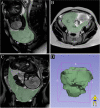Placental volume as a novel sign for identifying placenta accreta spectrum in pregnancies with complete placenta previa
- PMID: 38200440
- PMCID: PMC10777563
- DOI: 10.1186/s12884-024-06247-y
Placental volume as a novel sign for identifying placenta accreta spectrum in pregnancies with complete placenta previa
Abstract
Background: Placenta accreta spectrum (PAS) carries an increased risk of maternal-fetal mortality and morbidity, and magnetic resonance imaging (MRI) features for PAS have been used for preoperative identification. This study aims to investigate the role of placental volume evaluated by MRI in identifying PAS in pregnant women with complete placenta previa.
Methods: Totally 163 cases of complete placenta previa pregnant women with a history of cesarean section underwent MRI for suspected PAS were included. We categorized the patients into two groups according to the presence or absence of PAS, and the maternal-fetal perinatal outcomes and placental volume analyzed by 3D Slice software were compared.
Results: There were significantly more gravidity, parity, and number of previous cesarean delivery in the PAS group (P < 0.05). Significant differences were also found between the two groups with respect to the following baseline characteristics: gestational age at delivery, intraoperative blood loss, blood transfusion, and neonatal birth weight (P < 0.05). Of 163 women in the study, 7 (4.294%) required cesarean hysterectomy for high-grade PAS or pernicious bleeding during cesarean section, and PAS was confirmed with histologic confirmation in 6 (85.714%) cases. The placental volume in PAS group was greater than that in the non-PAS group (P < 0.05). With a threshold of more than 887 cm3, the sensitivity and specificity in identifying PAS were 85.531% and 83.907% respectively, with AUC 0.908 (95% CI: 0.853-0.948).
Conclusions: Placental volume may be a promising indicator of PAS in complete placenta previa patients with a history of cesarean section.
Keywords: Cesarean section; Complete placenta previa; Magnetic resonance imaging; Placenta accreta spectrum; Placental volume.
© 2024. The Author(s).
Conflict of interest statement
The authors declare no competing interests.
Figures



References
-
- Bowman ZS, Eller AG, Bardsley TR, et al. Risk factors for placenta accreta: a large prospective cohort. Am J Perinatol. 2014;31:799–804. - PubMed
MeSH terms
Grants and funding
LinkOut - more resources
Full Text Sources

